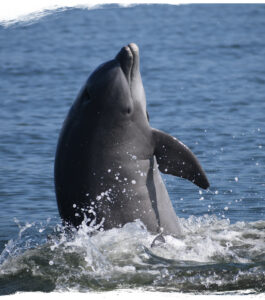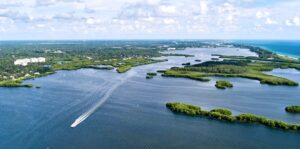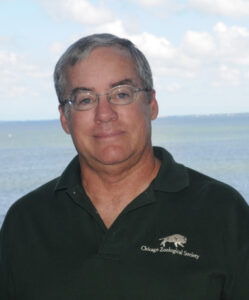So far, their population keeps growing, says the marine biologist who keeps track of them.
By Johannes Werner
Original Air Date: January 1, 2025
Johannes Werner: Dolphins are the top predator in the Sarasota Bay and Gulf shore ecosystem. As one local environmentalist put it: ‘If Flipper is OK, everything is OK’. So we talked to Dr. Randall Wells to find out how they are. Wells began studying bottlenose dolphins in Sarasota Bay as a high school volunteer at Mote Marine Laboratory in 1970. Today, he directs the Sarasota Dolphin Research Program, which conducts the world’s longest-running study of a wild dolphin population.
[Dolphin sound]
JW: That’s chatter between bottlenose dolphins. We cannot be sure what they communicate, but it’s probably not too bad news. That’s because their population keeps growing. While small in comparison to us humans — there are just about 170 in and around Sarasota Bay — the bottlenose dolphin population keeps growing at a rate of just more than 2% a year.
Randall Wells: In the most gross sense, the population, the community, as we refer to it, since it’s not a closed reproductive unit, the community has been increasing at a rate of about 2.1% on average since the 1990s, and the health data we have show that most of the animals are in pretty good shape.

Bottlenose Dolphin
JW: Dolphins don’t move around a lot. In the case of our bottle-nosed friends here, that’s not much farther than from the southern edge of Tampa Bay to Venice. That has given Wells and his team a chance to get to know them up-close over time.
RW: Our work has demonstrated that not only was there short-term residency, but there was a long-term residency that goes across decades and across generations within maternal lineages, such that we now have been studying six generations of dolphins since the beginning of the program. At any given time, we can have dolphins spanning up to five concurrent generations within the lineage, all in the same community, home range, with individuals up to 67 years of age. The oldest one that we’ve documented is estimated at 67 years of age. That’s when she disappeared. Very rarely do they make it more than 50, especially the males. Females sometimes make it into their 60s. Our primary means is by just keeping close track of them. We have our boats on the water 10 days each month, monitoring the Sarasota Bay dolphins, and we’re using a technique called photographic identification, where we take advantage of the fact that the fins on the dolphins’ back, the dorsal fins, each have distinctive markings on them. To a trained observer there’s a distinctive mix of notches.
JW: There are enough reasons to worry, though. Wells’ current research focuses on the effects of boat traffic, fishing activities, human feeding of wild dolphins, and environmental contaminants. He’s also looking at the impacts of algae blooms and red tides. Two particular concerns are micro plastics and fishing gear.
RW: We’re looking at the health of the animals beyond just what your doctor will do. We’re also looking for indications of environmental contaminants in the dolphins’ tissues, and we find these. And probably the most recent, most concerning bit that we’re finding are microplastics and phthalates, the chemicals that go along with these plastics. We’ve been finding them in every one of the dolphins that we sampled. The biggest threat that our dolphins face in this area comes from recreational fishing gear. They get entangled in the terminal tackle and the line. They get hooked by it. And of the dolphins that have been able to be assessed by Mote Marine Laboratory’s stranding investigations program — where they collect the carcasses of dolphins in this area and examine them — in the ones that they’ve been able to determine the cause of death, 20% of the animals have died from fishing gear interactions.

Little Sarasota Bay
JW: Part of the reason we see the dolphin population grow is due to the fact that Wells’ team intervenes when it learns about an individual dolphin in trouble with fishing gear.
But then, there are big challenges made bigger by human activity. Red Tide has intensified, and it has caused massive fish kills in Sarasota Bay. How does that affect dolphins?
RW: On a seasonal basis, we go out and and measure the abundance of dolphin prey fish, and are able to relate that to what goes on with the dolphins, and their behavior and their health. So what we find is that with a severe Red Tide, similar to what we had in 2005-06 or in 2018-19, more than 75% of the dolphins prey fish will be lost.
The dolphins stay in their community range. [Because] of that, they have to take advantage of whatever fish remain, which may cost them more to catch and not have as much of a caloric reward. So they take advantage of what’s left, and it also puts them in greater contact and conflict with anglers who are also vying for those same few remaining fish. And that’s when we see the greatest instances of problems with fishing gear.

Randall Wells
JW: Do you see starvation?
RW: What we see is decline in body condition for those animals, especially the young animals that are just learning how to catch fish. In 2006, we lost half of our two-year olds. Two percent of the local dolphins died due to ingestion of fish. But what we’ve been able to see with those fishing studies is that Sarasota Bay is pretty resilient. We find that even when we lose 75-80% of the dolphin prey fish, within a year the numbers of those fish are back up to what they were pre-Red Tide.
JW: And then there is climate change and warming waters. Heat is a challenge for dolphins.
RW: There’s no smoking gun that we can point to, but what we see is that these dolphins have their highest mortality rates during the heat of the summertime.
JW: Are dolphins migrating northward?
RW: We have not seen that here. There are other, many other organisms that the National Marine Fishery Service is tracking along the eastern seaboard, where their movements are going to the north as these waters warm. Our dolphins don’t really have that option. It’s not going to do them any good to go to the north in the Gulf of Mexico as it’s all hot in the Gulf of Mexico. And they also don’t do that. One of the things that’s been really remarkable to us is that they live in what we refer to as an ecological cul de sac. They, no matter how bad things have gotten so far, they stay within their community range. And whether that’s because the societies and the communities on all sides have been so long established and well established that you can’t get into it, we just don’t know what the reasons are, but they are very much homebodies.
JW: To find out more about dolphins in and around Sarasota Bay and Dr. Randall Wells’ research, go to www.SarasotaDolphin.org.
Reporting from Sarasota Bay for WSLR News, Johannes Werner
WSLR News aims to keep the local community informed with our 1/2 hour local news show, quarterly newspaper and social media feeds. The local news broadcast airs on Wednesdays and Fridays at 6pm.